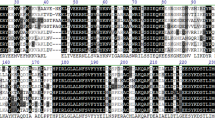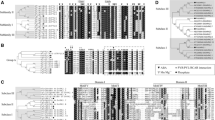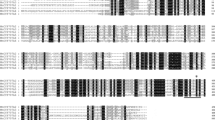Abstract
14-3-3 proteins play important roles in regulating plant development and phytohormone (abscisic acid, gibberellin and brassinosteroids) signalling. However, their regulation in fruit ripening and senescense, and response to salicylic acid and ethylene signalling are yet to be illustrated. One cDNA encoding putative 14-3-3 protein was isolated from pear (Pyrus pyrifolia) and designated Pp14-3-3a. Phylogenetic analysis clearly demonstrated that Pp14-3-3a belonged to ε-like group of 14-3-3 superfamilies. Real-time quantitative PCR analysis indicated that the expression ofPp14-3-3a gene was developmentally regulated in the fruit. Further study demonstrated that Pp14-3-3a expression was inhibited by salicylic acid and induced by ethylene precursor 1-aminocyclopropane-1-carboxylic acid in pear fruit. These data suggested that Pp14-3-3a might be involved in response to salicylic acid and ethylene signalling during fruit ripening and senescence of pear.






Similar content being viewed by others
References
Aitken A. 2006 14-3-3 proteins: a historic overview. Semin. Cancer Biol. 16, 162–172.
Alba R., Payton P., Fei Z., McQuinn R., Debbie P., and Martin G. B. 2005 Transcriptome and selected metabolite analyses reveal multiple points of ethylene control during tomato fruit development. Plant Cell 17, 2954–2965.
Bridges D. and Moorhead G. B. 2005. 14-3-3 proteins: a number of functions for a numbered protein. Sci. STKE, re10.
Capitani G., Hohenester E., Feng L., Storici P., Kirsch J. F., and Jansonius J. N. 1999 Structure of 1-aminocyclopropane-1-carboxylate synthase, a key enzyme in the biosynthesis of the plant hormone ethylene. J. Mol. Biol. 294, 745–756.
Chaudhri M., Scarabel M. and Aitken A. 2003 Mammalian and yeast 14-3-3 isoforms form distinct patterns of dimers in vivo. Biochem. Biophys. Res. Commun. 3, 679–685.
Chevalier D., Morris E. R., and Walker J. C. 2009 14-3-3 and FHA domains mediate phosphoprotein interactions. Annu. Rev. Plant Biol. 60, 67–91.
Comparot S., Lingiah G., and Martin T. 2003 Function and specificity of 14-3-3 proteins in the regulation of carbohydrate and nitrogen metabolism. J. Exp. Bot. 54, 595–604.
Darling D. L., Yingling J., and Wynshaw-Boris A. 2005 Role of 14-3-3 proteins in eukaryotic signaling and development. Curr. Top. Dev. Biol. 68, 281–315.
Denison F. C., Paul A. L., Zupanska A. K., and Ferl R. J. 2011 14-3-3 proteins in plant physiology. Semin. Cell Dev. Biol. 22, 720–727.
Dougherty M. K. and Morrison D. K. 2004 Unlocking the code of 14-3-3. J. Cell Sci. 117, 1875–1884.
Freeman A. K. and Morrison D. K. 2011 14-3-3 proteins: diverse functions in cell proliferation and cancer progression. Semin. Cell Dev. Biol. 22, 681–687.
Gampala S. S., Kim T. W., He J. X., Tang W., Deng Z., Bai M. Y. et al. 2007 An essential role for 14-3-3 proteins in brassinosteroid signal transduction in Arabidopsis. Dev. Cell. 13, 177–189.
Ganguly S., Weller J. L., Ho A., Chemineau P., Malpaux B., and Klein D. C. 2005 Melatonin synthesis. 14-3-3-Dependent activation and inhibition of arylalkylamine N-acetyltransferase mediated by phosphoserine-205. Proc. Natl. Acad. Sci. USA 102, 1222–1227.
Giovannoni J. 2001 Molecular biology of fruit maturation and ripening. Annu. Rev. Plant Physiol. Plant Mol. Biol. 52, 725–749.
Hassan I., Zhang Y. X., Du G. Q., Wang G. Y., and Zhang J. H. 2007 Effect of salicylic acid (SA) on delaying fruit senescence of Huang Kum pear. Front. Agric. Chin. 1, 456–459.
Igarashi D., Ishida S., Fukazawa J., and Takahashi Y. 2001 14-3-3 proteins regulate intracellular localization of the bZIP transcriptional activator RSG. Plant Cell 13, 2483–2497.
Ishida S., Fukazawa J., Yuasa T., and Takahashi Y. 2004 Involvement of 14-3-3 signaling protein binding in the functional regulation of the transcriptional activator REPRESSION OF SHOOT GROWTH by gibberellins. Plant Cell 16, 2641–2651.
Johnson C., Crowther S., Stafford M. J., Campbell D. G., Toth R., and MacKintosh C. 2010 Bioinformatic and experimental survey of 14-3-3 binding sites. Biochem. J. 427, 69–78.
Lu G., DeLisle A. J, de Vetten N.-C. and Ferl R. J. 1992 Brain proteins in plants: an Arabidopsis homolog to neurotransmitter pathway activators is part of a DNA binding complex. Proc. Natl. Acad. Sci. USA 89, 11490–11494.
Mayfield J. D., Folta K. M., Paul A. L. and Ferl R. J. 2007 The 14-3-3 proteins mu and upsilon influence transition to flowering and early phytochrome response. Plant Physiol. 145, 1692–1702.
Mayfield J. D., Paul A. L. and Ferl R. J. 2012 The 14-3-3 proteins of Arabidopsis regulate root growth and chloroplast development as components of the photosensory system. J. Exp. Bot. 63, 3061–3070.
Moore B. W. and Perez V. J. 1967. Specific acidic proteins of the nervous system. In Physiological and biochemical aspects of nervous integration. (ed F. D. Carlson), pp. 343–359. Prentice Hall, Englewood Cliffs, USA.
Muslin A. J., Tanner J. W., Allen P. M., and Shaw A. S. 1996 Interaction of 14-3-3 with signaling proteins is mediated by the recognition of phosphoserine. Cell 84, 889–897.
Laughner B., Lawrence S. D., and Ferl R. J. 1995 Two cDNA clones encoding 14-3-3 homologs from tomato fruit. Biochim. Biophys. Acta 1263, 67–70.
Li M. Y., Xu B. Y., Liu J. H., Yang X. L., Zhang J. B., Jia C. H. et al. 2012 Identification and expression analysis of four 14-3-3 genes during fruit ripening in banana (Musa acuminata L. AAA group, cv. Brazilian). Plant Cell Rep. 31, 369–378.
Li X. B., Fan X. P., Wang X. L., Cai L. and Yang W. C. 2005 The cotton ACTIN1 gene is functionally expressed in fibers and participates in fiber elongation. Plant Cell 17, 859–875.
Liu D., Bienkowska J., Petosa C., Collier R. J., Fu H., and Liddington R. 1995 Crystal structure of the isoform of the 14-3-3 protein. Nature 376, 191–194.
Oecking C. and Jaspert N. 2009 Plant 14-3-3 proteins catch up with their mammalian orthologs. Curr. Opin. Plant Biol. 12, 760–765.
Purwestri Y. A., Ogaki Y., Tamaki S., Tsuji H. and Shimamoto K. 2009 The 14-3-3 protein GF14c acts as a negative regulator of flowering in rice by interacting with the florigen Hd3a. Plant Cell Physiol. 50, 429–438.
Roberts M. R. 2003 14-3-3 proteins find new partners in plant cell signalling. Trends Plant Sci. 8, 218–223.
Ryu H., Kim K., Cho H., Park J., Choe S. and Hwang I. 2007 Nucleocytoplasmic shuttling of BZR1 mediated by phosphorylation is essential in Arabidopsis brassinosteroid signaling. Plant Cell 19, 2749–2762.
Schoonheim P. J., Veiga H., da Pereira D. C., Friso G., van Wijk K. J., and de Boer A. H. 2007 A comprehensive analysis of the 14-3-3 interactome in barley leaves using a complementary proteomics and two-hybrid approach. Plant Physiol. 143, 670–683.
Sehnke P. C., DeLille J. M. and Ferl R. J. 2002a Consummating signal transduction: the role of 14-3-3 proteins in the completion of signal-induced transitions in protein activity. Plant Cell 14, 339–354.
Sehnke P. C., Rosenquist M., Alsterfjord M., DeLille J., Sommarin M., Larsson C. and Ferl R. J. 2002b Evolution and isoform specificity of plant 14-3-3 proteins. Plant Mol. Biol. 50, 1011–1018.
Shi H., Zhu L., Zhou Y., Li G., Chen L. and Li X. 2009 A cotton gene encoding a polygalacturonase inhibitor-like protein is specifically expressed in petals. Acta Biochem. Biophy. Sin. 41, 316–324.
Shi H. Y. and Zhang Y. X. 2012 Pear ACO genes encoding putative 1-aminocyclopropane-1-carboxylate oxidase homologs are functionally expressed during fruit ripening and involved in response to salicylic acid. Mol. Biol. Rep. 39, 9509–9519.
Srivastava M. K. and Dwivedi U. N. 2000 Delayed ripening of banana fruit by salicylic acid. Plant Sci. 158, 87–96.
Tzivion G. and Avruch J. 2002 14-3-3 Proteins: active cofactors in cellular regulation by serine/threonine phosphorylation. J. Biol. Chem. 277, 3061–3064.
Valero D., Diaz-Mula H. M., Zapata P. J., Castillo S., Guillen F., Martinez-Romero D. and Serrano M. 2011 Postharvest treatments with salicylic acid, acetylsalicylic acid or oxalic acid delayed ripening and enhanced bioactive compounds and antioxidant capacity in sweet cherry. J. Agric. Food Chem. 59, 5483–5489.
van Hemert M. J., Steensma H. Y. and van Heusden G. P. 2001 14-3-3 proteins: key regulators of cell division, signaling and apoptosis. Bioessays 23, 936–946.
Wilkinson J. Q., Lanahan M. B., Clark D. G., Bleecker A. B., Chang C., Meyerowitz E. M. and Klee H. J. 1997 A dominant mutant receptor from Arabidopsis confers ethylene insensitivity in heterologous plants. Nat. Biotechnol. 15, 444–447.
Wu K., Rooney M. F. and Ferl R. J. 1997 The Arabidopsis 14-3-3 multigene family. Plant Physiol. 114, 1421–1431.
Xiao B., Smerdon S. J., Jones D. H., Dodson G. G., Soneji Y., Aitken A., and Gamblin S. J. 1995 Structure of a 14-3-3 protein and implications for coordination of multiple signaling pathways. Nature 376, 188–191.
Xu W. F. and Shi W. M. 2006 Expression profiling of the 14-3-3 gene family in response to salt stress and potassium and iron deficiencies in young tomato (Solanum lycopersicum) roots: analysis by real-time RT-PCR. Ann. Bot. 98, 965–974.
Xu W., Shi W., Jia L., Liang J., and Zhang J. 2012 TFT6 and TFT7, two different members of tomato 14-3-3 gene family, play distinct roles in plant adaption to low phosphorus stress. Plant Cell Environ. 35, 1393–1406.
Yang J. L., ChenW.W., Chen L. Q., Qin C., Jin C.W., Shi Y. Z. and Zheng S. J. 2013 The 14-3-3 protein GENERAL REGULATORY FACTOR11 (GRF11) acts downstream of nitric oxide to regulate iron acquisition in Arabidopsis thaliana. New Phytol. 197, 815–824.
Yang S. F. and Hoffman N. E. 1984 Ethylene biosynthesis and its regulation in higherplants. Annu. Rev. Plant Physiol. 35, 155–189.
Acknowledgements
This work was supported by the Research Fund for the Doctoral Programme of Higher Education of China (grant no. 2012130-2120004), the Hebei Province Science Foundation of China (grant no. C2013204051) and the National Natural Sciences Foundation of China (grant no. 31301761).
Author information
Authors and Affiliations
Corresponding author
Additional information
Shi H. and Zhang Y. 2014 Pear 14-3-3a gene (Pp14-3-3a) is regulated during fruit ripening and senescense, and involved in response to salicylic acid and ethylene signalling. J. Genet. 93, xx–xx
Rights and permissions
About this article
Cite this article
SHI, H., ZHANG, Y. Pear 14-3-3a gene (Pp14-3-3a) is regulated during fruit ripening and senescense, and involved in response to salicylic acid and ethylene signalling. J Genet 93, 747–753 (2014). https://doi.org/10.1007/s12041-014-0447-z
Received:
Revised:
Accepted:
Published:
Issue Date:
DOI: https://doi.org/10.1007/s12041-014-0447-z




